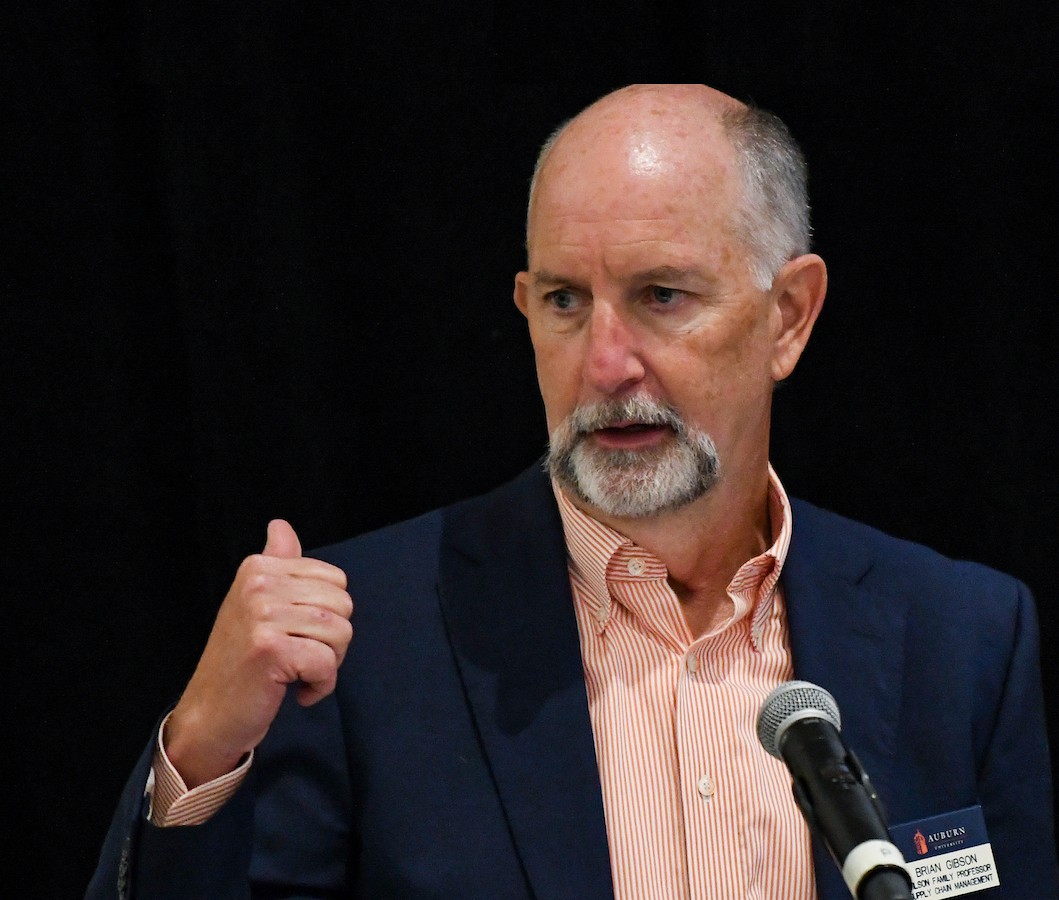 |
USPS "freezer farms" are capable of holding pharmaceuticals requiring storage at minus
80 degrees Celsius.
|
In a recent Wall Street Journal article entitled “COVID-19 Vaccine Delivery Will Challenge Cargo Airlines” Doug Cameron, the WSJ’s Deputy Bureau Chief in Chicago, lays out what pharmaceutical
makers, cargo shipper and the entire medical services industry will face in delivering
yet-to-be-approved vaccines to hospitals, medical offices and pharmacies across the
United States and around the globe. Cameron’s article focuses on the air cargo segment
of this specialized supply chain, which is already suffering from a shortage of planes
equipped with the carefully controlled refrigeration transport and storage these vaccines
will require. His findings in that segment of the vaccine supply chain raise real
concerns and beg the question of what else needs to be done to ensure virtually every
step in this critical health care delivery process succeeds.
Glenn Richey, Harbert Eminent Scholar and Chair of the Department of Supply Chain
Management at Auburn University’s Harbert College of Business, points out that the
air transport leg is only one link in this complex supply chain—and far from the most
challenging. In a recent interview, Richey identifies a host of supply chain issues
embedded in the forthcoming delivery of approved COVID-19 vaccines and offers insight
into what needs to be done to ensure success.
HCOB: Let’s start with what makes vaccines different from other cargo, even other refrigerated
cargo, when it comes to ensuring the safe, reliable delivery of hundreds of millions
of doses like what’s coming for COVID-19.
Richey: The refrigeration requirements for these vaccines will go beyond traditional cold
shipping and storage capabilities. The most promising vaccines under development will
have to be kept at an extremely low constant temperature from production to the patient
in order to prevent spoiling. Experts expect there to be two temperature ranges depending
on the vaccine: around freezing and minus 70 degrees Celsius. Each of these two ranges
presents a significantly different challenge to transport and storage planners working
to ensure the safety of vaccines delivered to health care providers and their patients.
That’s number one.
Number two is that the issue of spoilage goes beyond patient safety—these vaccines
are expected to be in scarce supply early on, there may not be enough to go around.
With pharma executives reporting typical spoilage rates for other vaccines during
transport at 5% to as much as 20% because of inadequate temperature control, getting
cold storage shipping control just right is critical to the expansion of availability.
And finally, we’re talking huge volumes—Pfizer and one of their manufacturing partners,
BioNTech, are among a handful of companies in advanced stages of testing their vaccine.
These two companies alone are contractually committed to supplying over 450 million doses to U.S. and foreign governments once they have
completed trials showing the vaccine to be safe and effective. High volume shipments
of millions of doses will trim down to deliveries of 100 or less by the time they
reach your local provider.
So, to be clear, it’s a whole new ball game.

HCOB: So where does the transportation component of supply chain management come into all
of this, and where does it rank in terms of “must do” priorities?
Richey: According to the IFPMA (International Federation of Pharmaceutical Manufacturers & Associations), the transport and storage component of the supply chain is at the top of their
list of concerns. The IFPMA recently reported that optimization of supply chain is
extremely important to reduce the cold chain footprint, limit waste, and increase
vaccination coverage and safety. And the public’s trust in these vaccines may be eroded
if people fear the vaccines have been mishandled. So, this is a uniquely challenging
endeavor.
 |
Workers at FedEx use dry ice to ship vaccines.
|
HCOB: In his article, the WSJ’s Doug Cameron focuses on the air cargo phase of the vaccine
delivery process, commenting on everything being done to ensure high volume quantities
of approved vaccines get to major airports and the refrigeration storage facilities
being built nearby to hold them. But that’s just the first leg of transport, right?
What happens to these vaccines once they land?
Richey: That’s correct—and ensuring delivery through that first leg is no small feat. But
pharmaceutical companies and their shippers are experienced in this, and they appear
to be building contingency plans for the bulk transport and storage capabilities necessary
to get vaccines into large metropolitan areas and even to regional airports that serve
surrounding populations. It is the next phase of the distribution process where it
can get tricky—on the ground. From long-haul truckers to short-route delivery vans,
fleets with specialized refrigeration capabilities will have to be allocated to get
vaccines to where they are needed: hospitals, medical offices and even drug stores
like CVS and Walgreens.
HCOB: Let’s start with long-haul truckers, those with refrigerated semi tractor-trailers—“reefer
trucks”, as they’re called—are they in as high demand as refrigerated air cargo planes?
Richey: I’d say perhaps even higher. For one thing, reefer trucks are already in tight supply
due to the shifts in ground transportation of produce and other foods during COVID-19.
There simply aren’t enough to meet demand, especially over the time frame when the
first vaccines are expected to become available—the coming holiday season. The growth
of e-commerce—already on a steep ramp before the pandemic—has scooped up capacity
from retailers struggling from severe declines in brick-and-mortar foot traffic. Savvy
businesses have already worked to reserve ground shipping capacity for the next three
months, just when vaccine makers are expected to begin delivery.
And truck manufacturers are responding to the coming uptick in demand. FTR Transportation
Intelligence, which tracks orders of semis and trailers, recently reported a tremendous uptick in orders. According to FTR, “Dry van orders were particularly
robust, with refrigerated vans also displaying strength…Backlogs are expected to rise
to near pre-pandemic levels.” While these recent orders are encouraging, deliveries
of this new capacity are at least four months out.
 |
FedEx uses proprietary shipping containers to ensure cold chain delivery of vaccines.
|
HCOB: What about local delivery fleets, those serving the “last mile” leg needed to reach
smaller medical facilities and drug stores—how equipped are major delivery providers
like FedEx, UPS and even the US Postal Service to provide the tightly monitored delivery
of cold chain vaccines to all these points of care?
Richey: That’s going to be complex as well. Think of the sheer number of certified refrigeration
units that will need to be manufactured, purchased, delivered, and brought into operation
by a wide variety of regional and local shippers—that alone will be a challenge. Then
consider all the processes and procedures that will need to be put into place—how
often are the vaccine shipments tested to ensure vitality and sterility? Who is responsible
for ensuring the chain isn’t broken—and if it is, who is liable? All the large shippers
have access to specialized liability insurance to cover these circumstances, but smaller
shippers may not, further compounding the coming squeeze.
HCOB: That all sounds ominous, are all these efforts bound to fail? Can nothing be done?
Richey: No, there’s still time to act. But it will likely take an all-hands-on-deck, tightly
coordinated effort by federal, state, and local government working hand in hand with
private industry to pull it off. From what I’ve read, some of that is already happening
through Operation Warp Speed.
HCOB: What advice would you give the members of Operation Warp Speed as the plan for the
coming roll-out of vaccines?
Richey: I assume the members of Operation Warp Speed are pulling together the very best in
pharmaceutical development and delivery and are well into their planning process.
Among the “advice” I would give them would include the following major considerations
and steps:
- Map it out—How many vaccines need to go where, when and by which routes and carriers? Prioritizing
the most vulnerable—doctors, nurses, hospital staff and other first responders—will
be key, and documenting the successes and failures of the initial roll-out to them
before ramping up volume shipments to patients themselves can help refine best practices
going forward.
- Reserve space now—It is better to have sufficient capacity contracted now rather than to wait until
a more definitive estimate of vaccine availability emerges and cold storage capacity
is harder to find. It is not a matter of “if” but “when.”
- Engage Defense Department and other government logistics expertise—The military has decades of proven expertise getting medical supplies into some of
the most forbidding places on earth, surely those skills, procedures and equipment
can serve a valuable role in the delivery of these vaccines. FEMA, too, has a place
in this process—they have extraordinary capabilities to act in a crisis like the one
we face in the coming months. These resources are typically called upon in an emergency—and
this pandemic certainly counts as one.
- Finally, tap into American ingenuity—we lead the world in medical device technology, and our businesses have the ability
to create new products and services to meet the needs of cold chain vaccine delivery,
to pivot design skills and manufacturing capacity of new technologies, new methodologies.
Auto manufacturers and others responded to the need for ventilators, we can do it
again with cold storage and transport.
Learn more about Auburn University's Supply Chain Management Department.

 Degrees & Programs
Degrees & Programs
 Faculty & Staff
Faculty & Staff
 Career Development
Career Development
 Recruiters & Industry
Recruiters & Industry







